Essay on International Human Resource Management and Strategies
VerifiedAdded on 2020/04/07
|15
|3202
|383
Essay
AI Summary
This essay provides a comprehensive overview of International Human Resource Management (IHRM), emphasizing its significance in the context of globalization and the expansion of businesses into international markets. It defines IHRM as the process of acquiring, assigning, and utilizing human resources in a global company, while balancing differentiation and integration of HR activities across various countries. The essay explores key elements of HR strategy, including recruitment, training, performance assessment, and compensation. It highlights the differences between domestic and global management, addressing challenges related to cultural differences and boundary spanning. Furthermore, the essay discusses various strategies for international managers, such as ethnocentric, polycentric, and global approaches, and their implications on staffing and employee management. It also delves into the challenges faced by IHRM, including cross-cultural management, language barriers, and cultural diversity. The essay concludes by emphasizing the importance of reward strategies and the need for international HR managers to address these challenges to ensure the success of global operations.
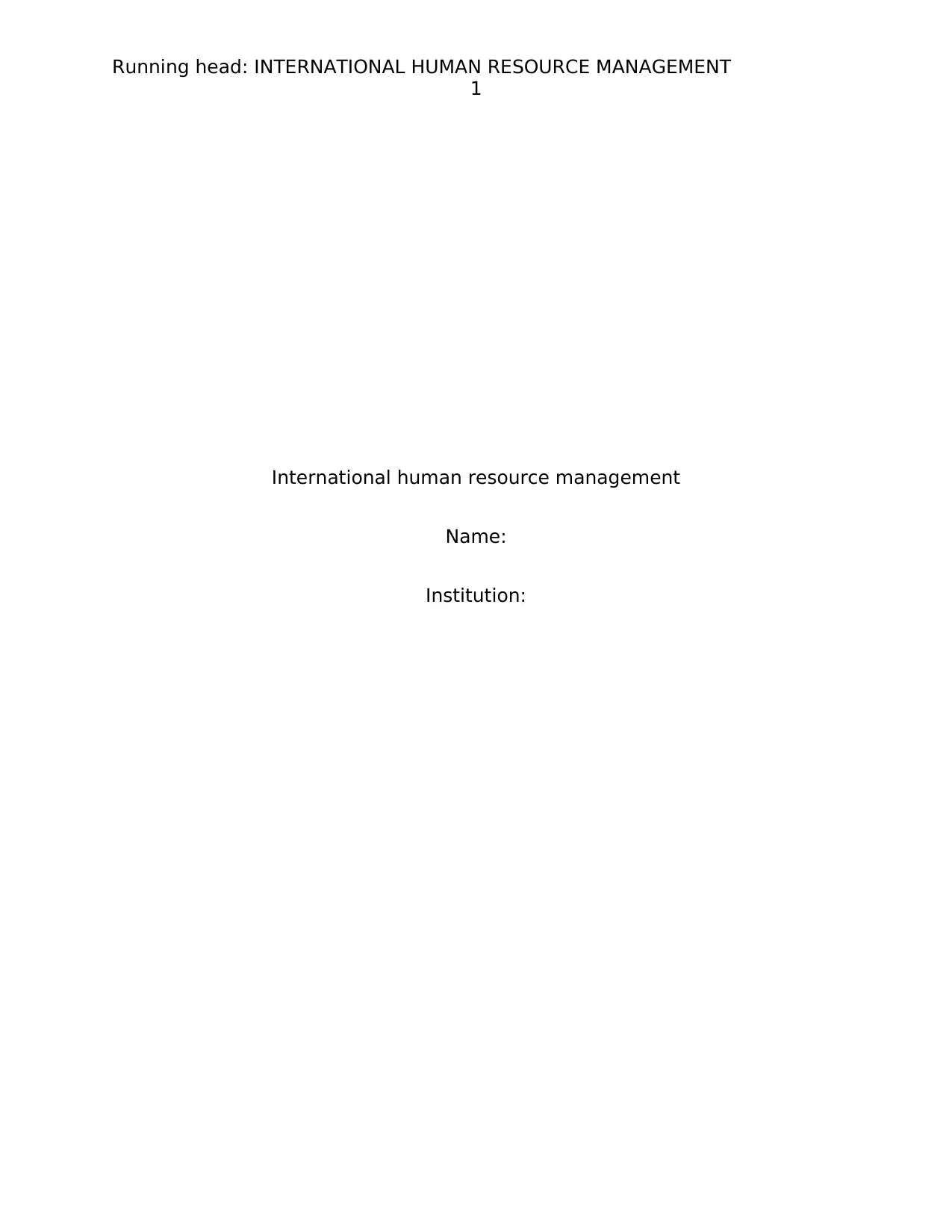
Running head: INTERNATIONAL HUMAN RESOURCE MANAGEMENT
1
International human resource management
Name:
Institution:
1
International human resource management
Name:
Institution:
Paraphrase This Document
Need a fresh take? Get an instant paraphrase of this document with our AI Paraphraser

INTERNATIONAL HUMAN RESOURCE MANAGEMENT 2
Introduction
Human resource management comprises the employment practices
and firm’s work systems embracing a common aspect of the people
management. Human resource management encompasses recruitment and
selection, training and development, human resource planning, employee
performance assessment, payment and reward systems, and most important
to align employee development corporate strategies (Sparrow, Brewster, &
Chung, 2016). International human resource management is all about the
relationship between the foreign environment and human resource activities
in which the firm operates. Due to the globalization, there is an integration of
the economy globally. Competitive advantage as result of the untouched
market segment makes companies to expand to their market to the other
countries (Bratton & Gold, 2012). The determinant of firm’s performance and
competitive advantage depends upon the effectiveness of the human
resource management. International human resource management can be
termed as a process of acquiring, designating and using human resources in
a global company, while trying to maintaining differentiation and integration
balance of human resources activities in other countries. This essay seeks to
discuss the international human resource management in relation to the key
elements of the HR strategy.
The success of the domestic business relies on the human resource
management. Human resource managers are responsible for managing a
Introduction
Human resource management comprises the employment practices
and firm’s work systems embracing a common aspect of the people
management. Human resource management encompasses recruitment and
selection, training and development, human resource planning, employee
performance assessment, payment and reward systems, and most important
to align employee development corporate strategies (Sparrow, Brewster, &
Chung, 2016). International human resource management is all about the
relationship between the foreign environment and human resource activities
in which the firm operates. Due to the globalization, there is an integration of
the economy globally. Competitive advantage as result of the untouched
market segment makes companies to expand to their market to the other
countries (Bratton & Gold, 2012). The determinant of firm’s performance and
competitive advantage depends upon the effectiveness of the human
resource management. International human resource management can be
termed as a process of acquiring, designating and using human resources in
a global company, while trying to maintaining differentiation and integration
balance of human resources activities in other countries. This essay seeks to
discuss the international human resource management in relation to the key
elements of the HR strategy.
The success of the domestic business relies on the human resource
management. Human resource managers are responsible for managing a
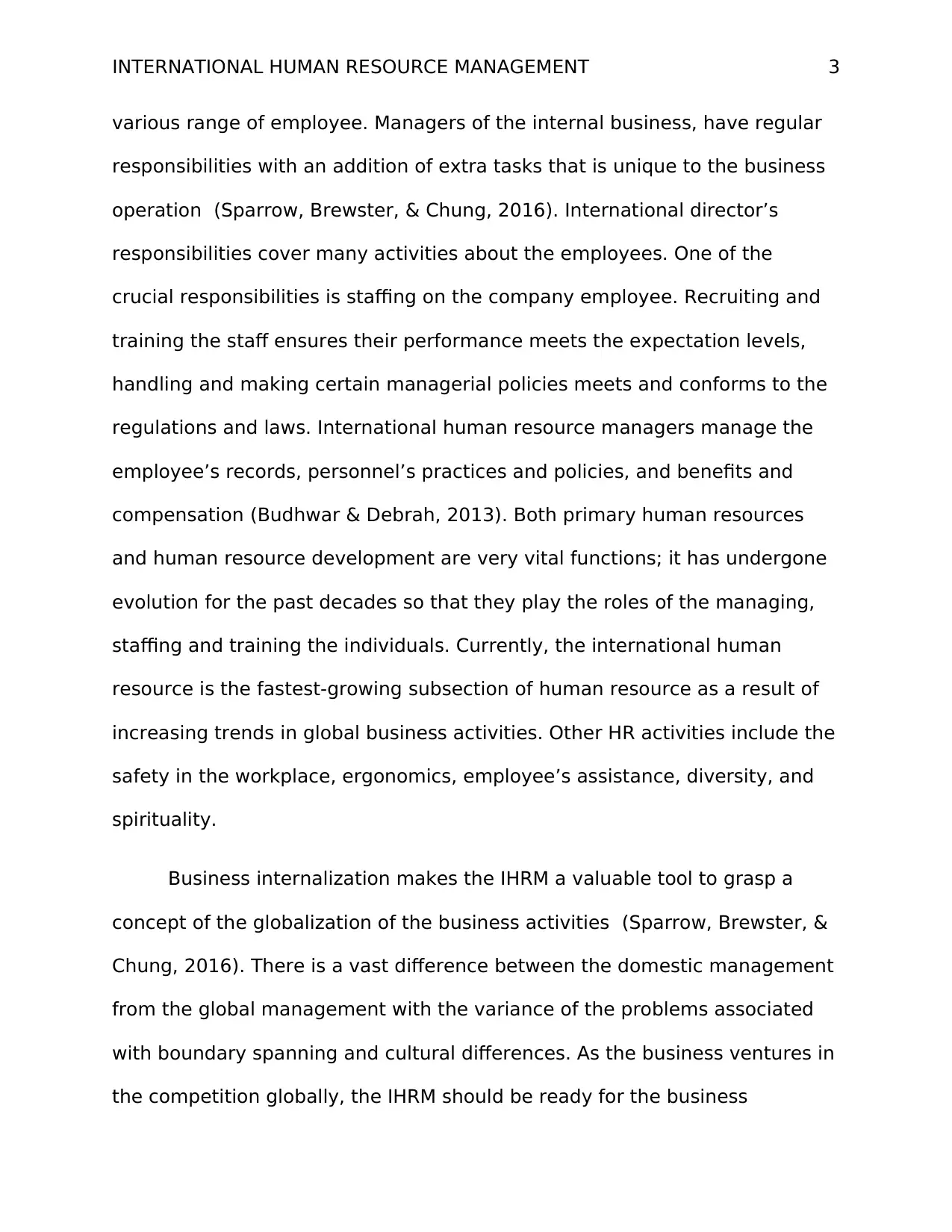
INTERNATIONAL HUMAN RESOURCE MANAGEMENT 3
various range of employee. Managers of the internal business, have regular
responsibilities with an addition of extra tasks that is unique to the business
operation (Sparrow, Brewster, & Chung, 2016). International director’s
responsibilities cover many activities about the employees. One of the
crucial responsibilities is staffing on the company employee. Recruiting and
training the staff ensures their performance meets the expectation levels,
handling and making certain managerial policies meets and conforms to the
regulations and laws. International human resource managers manage the
employee’s records, personnel’s practices and policies, and benefits and
compensation (Budhwar & Debrah, 2013). Both primary human resources
and human resource development are very vital functions; it has undergone
evolution for the past decades so that they play the roles of the managing,
staffing and training the individuals. Currently, the international human
resource is the fastest-growing subsection of human resource as a result of
increasing trends in global business activities. Other HR activities include the
safety in the workplace, ergonomics, employee’s assistance, diversity, and
spirituality.
Business internalization makes the IHRM a valuable tool to grasp a
concept of the globalization of the business activities (Sparrow, Brewster, &
Chung, 2016). There is a vast difference between the domestic management
from the global management with the variance of the problems associated
with boundary spanning and cultural differences. As the business ventures in
the competition globally, the IHRM should be ready for the business
various range of employee. Managers of the internal business, have regular
responsibilities with an addition of extra tasks that is unique to the business
operation (Sparrow, Brewster, & Chung, 2016). International director’s
responsibilities cover many activities about the employees. One of the
crucial responsibilities is staffing on the company employee. Recruiting and
training the staff ensures their performance meets the expectation levels,
handling and making certain managerial policies meets and conforms to the
regulations and laws. International human resource managers manage the
employee’s records, personnel’s practices and policies, and benefits and
compensation (Budhwar & Debrah, 2013). Both primary human resources
and human resource development are very vital functions; it has undergone
evolution for the past decades so that they play the roles of the managing,
staffing and training the individuals. Currently, the international human
resource is the fastest-growing subsection of human resource as a result of
increasing trends in global business activities. Other HR activities include the
safety in the workplace, ergonomics, employee’s assistance, diversity, and
spirituality.
Business internalization makes the IHRM a valuable tool to grasp a
concept of the globalization of the business activities (Sparrow, Brewster, &
Chung, 2016). There is a vast difference between the domestic management
from the global management with the variance of the problems associated
with boundary spanning and cultural differences. As the business ventures in
the competition globally, the IHRM should be ready for the business
⊘ This is a preview!⊘
Do you want full access?
Subscribe today to unlock all pages.

Trusted by 1+ million students worldwide

INTERNATIONAL HUMAN RESOURCE MANAGEMENT 4
corporation challenges (Bratton & Gold, 2012). Globalization of the firm
requires the IHRM to use appropriate knowledge management and human
resources policies considering the cultural differences.
Building on the same idea, there is a rapid increase in the global
operation and competition. Thus, international HRM should grow insignificant
as the international companies grow in the influences and numbers. The
primary determinant of the failure or the success in international business is
through efficient management of human resources internationally. According
to the research, the biggest problems for the foreign firms are the shortage
of the global managers.
Scholar argues that central practices of the HRM have evolved due to
globalization (Sparrow, Brewster, & Chung, 2016). Business tends to operate
in an international environment that has led to the development of the
international HRM.IHRM is management technique used by the managers on
a global scale. The primary purpose of the IHRM is to manage human
resources at international companies to gives companies opportunities to
grow while remaining competitive within its host country. Similar to the HRM,
the International HRM comprises the training, development of programs,
recruitment, performance appraisals, KPI’s, reward schemes and disciplinary
procedures (Bratton & Gold, 2012). There are three strategies which help
the international managers in reducing the complexity of the company’s
management.
corporation challenges (Bratton & Gold, 2012). Globalization of the firm
requires the IHRM to use appropriate knowledge management and human
resources policies considering the cultural differences.
Building on the same idea, there is a rapid increase in the global
operation and competition. Thus, international HRM should grow insignificant
as the international companies grow in the influences and numbers. The
primary determinant of the failure or the success in international business is
through efficient management of human resources internationally. According
to the research, the biggest problems for the foreign firms are the shortage
of the global managers.
Scholar argues that central practices of the HRM have evolved due to
globalization (Sparrow, Brewster, & Chung, 2016). Business tends to operate
in an international environment that has led to the development of the
international HRM.IHRM is management technique used by the managers on
a global scale. The primary purpose of the IHRM is to manage human
resources at international companies to gives companies opportunities to
grow while remaining competitive within its host country. Similar to the HRM,
the International HRM comprises the training, development of programs,
recruitment, performance appraisals, KPI’s, reward schemes and disciplinary
procedures (Bratton & Gold, 2012). There are three strategies which help
the international managers in reducing the complexity of the company’s
management.
Paraphrase This Document
Need a fresh take? Get an instant paraphrase of this document with our AI Paraphraser
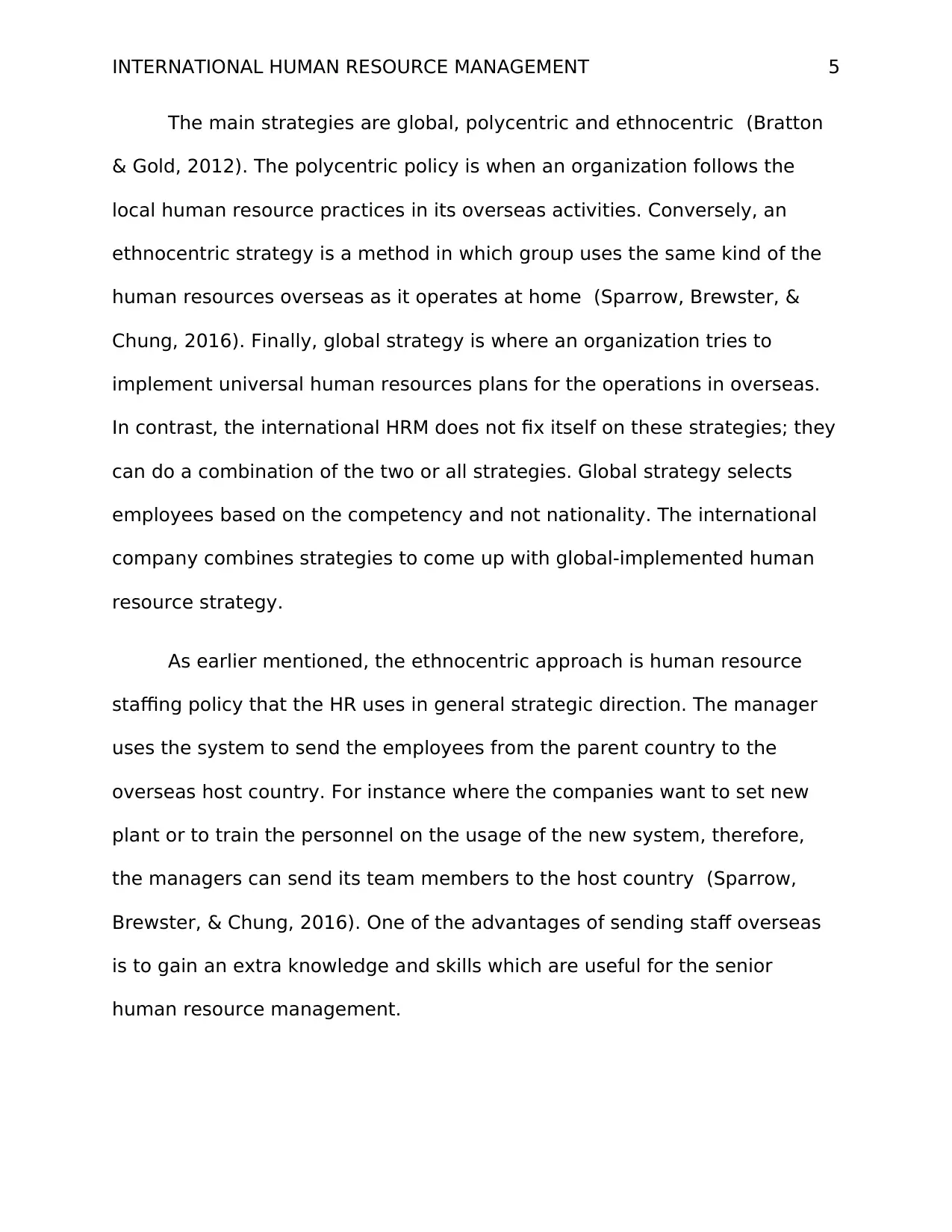
INTERNATIONAL HUMAN RESOURCE MANAGEMENT 5
The main strategies are global, polycentric and ethnocentric (Bratton
& Gold, 2012). The polycentric policy is when an organization follows the
local human resource practices in its overseas activities. Conversely, an
ethnocentric strategy is a method in which group uses the same kind of the
human resources overseas as it operates at home (Sparrow, Brewster, &
Chung, 2016). Finally, global strategy is where an organization tries to
implement universal human resources plans for the operations in overseas.
In contrast, the international HRM does not fix itself on these strategies; they
can do a combination of the two or all strategies. Global strategy selects
employees based on the competency and not nationality. The international
company combines strategies to come up with global-implemented human
resource strategy.
As earlier mentioned, the ethnocentric approach is human resource
staffing policy that the HR uses in general strategic direction. The manager
uses the system to send the employees from the parent country to the
overseas host country. For instance where the companies want to set new
plant or to train the personnel on the usage of the new system, therefore,
the managers can send its team members to the host country (Sparrow,
Brewster, & Chung, 2016). One of the advantages of sending staff overseas
is to gain an extra knowledge and skills which are useful for the senior
human resource management.
The main strategies are global, polycentric and ethnocentric (Bratton
& Gold, 2012). The polycentric policy is when an organization follows the
local human resource practices in its overseas activities. Conversely, an
ethnocentric strategy is a method in which group uses the same kind of the
human resources overseas as it operates at home (Sparrow, Brewster, &
Chung, 2016). Finally, global strategy is where an organization tries to
implement universal human resources plans for the operations in overseas.
In contrast, the international HRM does not fix itself on these strategies; they
can do a combination of the two or all strategies. Global strategy selects
employees based on the competency and not nationality. The international
company combines strategies to come up with global-implemented human
resource strategy.
As earlier mentioned, the ethnocentric approach is human resource
staffing policy that the HR uses in general strategic direction. The manager
uses the system to send the employees from the parent country to the
overseas host country. For instance where the companies want to set new
plant or to train the personnel on the usage of the new system, therefore,
the managers can send its team members to the host country (Sparrow,
Brewster, & Chung, 2016). One of the advantages of sending staff overseas
is to gain an extra knowledge and skills which are useful for the senior
human resource management.
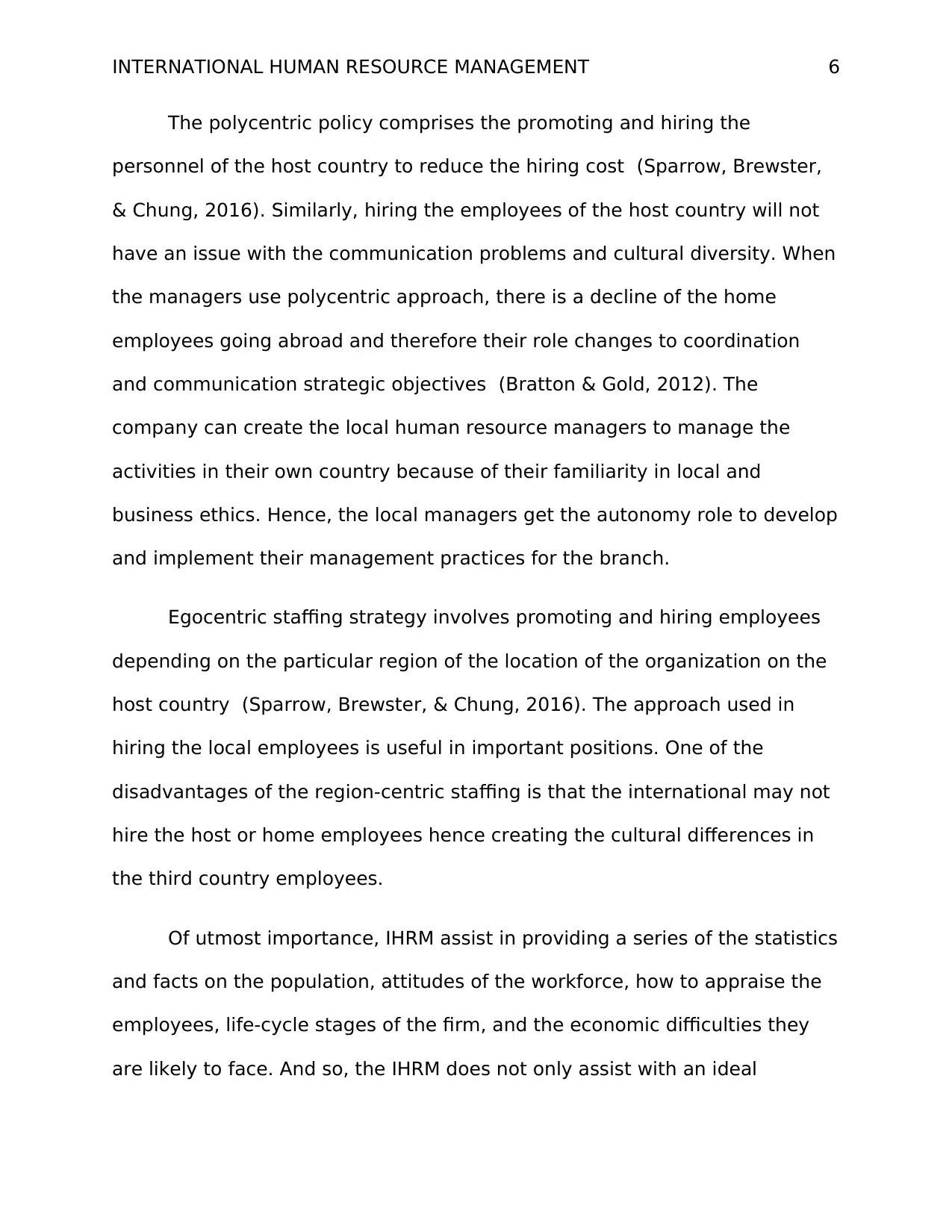
INTERNATIONAL HUMAN RESOURCE MANAGEMENT 6
The polycentric policy comprises the promoting and hiring the
personnel of the host country to reduce the hiring cost (Sparrow, Brewster,
& Chung, 2016). Similarly, hiring the employees of the host country will not
have an issue with the communication problems and cultural diversity. When
the managers use polycentric approach, there is a decline of the home
employees going abroad and therefore their role changes to coordination
and communication strategic objectives (Bratton & Gold, 2012). The
company can create the local human resource managers to manage the
activities in their own country because of their familiarity in local and
business ethics. Hence, the local managers get the autonomy role to develop
and implement their management practices for the branch.
Egocentric staffing strategy involves promoting and hiring employees
depending on the particular region of the location of the organization on the
host country (Sparrow, Brewster, & Chung, 2016). The approach used in
hiring the local employees is useful in important positions. One of the
disadvantages of the region-centric staffing is that the international may not
hire the host or home employees hence creating the cultural differences in
the third country employees.
Of utmost importance, IHRM assist in providing a series of the statistics
and facts on the population, attitudes of the workforce, how to appraise the
employees, life-cycle stages of the firm, and the economic difficulties they
are likely to face. And so, the IHRM does not only assist with an ideal
The polycentric policy comprises the promoting and hiring the
personnel of the host country to reduce the hiring cost (Sparrow, Brewster,
& Chung, 2016). Similarly, hiring the employees of the host country will not
have an issue with the communication problems and cultural diversity. When
the managers use polycentric approach, there is a decline of the home
employees going abroad and therefore their role changes to coordination
and communication strategic objectives (Bratton & Gold, 2012). The
company can create the local human resource managers to manage the
activities in their own country because of their familiarity in local and
business ethics. Hence, the local managers get the autonomy role to develop
and implement their management practices for the branch.
Egocentric staffing strategy involves promoting and hiring employees
depending on the particular region of the location of the organization on the
host country (Sparrow, Brewster, & Chung, 2016). The approach used in
hiring the local employees is useful in important positions. One of the
disadvantages of the region-centric staffing is that the international may not
hire the host or home employees hence creating the cultural differences in
the third country employees.
Of utmost importance, IHRM assist in providing a series of the statistics
and facts on the population, attitudes of the workforce, how to appraise the
employees, life-cycle stages of the firm, and the economic difficulties they
are likely to face. And so, the IHRM does not only assist with an ideal
⊘ This is a preview!⊘
Do you want full access?
Subscribe today to unlock all pages.

Trusted by 1+ million students worldwide
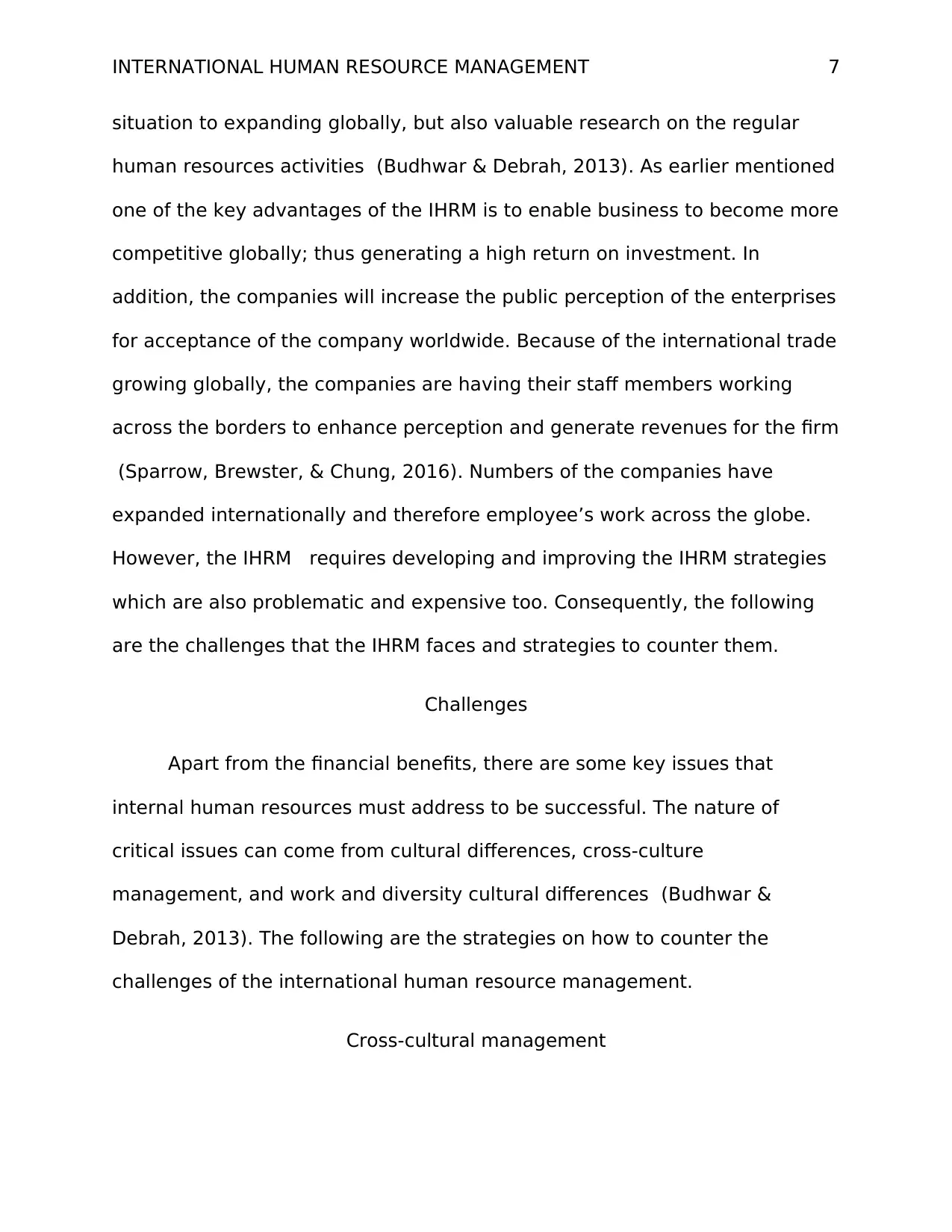
INTERNATIONAL HUMAN RESOURCE MANAGEMENT 7
situation to expanding globally, but also valuable research on the regular
human resources activities (Budhwar & Debrah, 2013). As earlier mentioned
one of the key advantages of the IHRM is to enable business to become more
competitive globally; thus generating a high return on investment. In
addition, the companies will increase the public perception of the enterprises
for acceptance of the company worldwide. Because of the international trade
growing globally, the companies are having their staff members working
across the borders to enhance perception and generate revenues for the firm
(Sparrow, Brewster, & Chung, 2016). Numbers of the companies have
expanded internationally and therefore employee’s work across the globe.
However, the IHRM requires developing and improving the IHRM strategies
which are also problematic and expensive too. Consequently, the following
are the challenges that the IHRM faces and strategies to counter them.
Challenges
Apart from the financial benefits, there are some key issues that
internal human resources must address to be successful. The nature of
critical issues can come from cultural differences, cross-culture
management, and work and diversity cultural differences (Budhwar &
Debrah, 2013). The following are the strategies on how to counter the
challenges of the international human resource management.
Cross-cultural management
situation to expanding globally, but also valuable research on the regular
human resources activities (Budhwar & Debrah, 2013). As earlier mentioned
one of the key advantages of the IHRM is to enable business to become more
competitive globally; thus generating a high return on investment. In
addition, the companies will increase the public perception of the enterprises
for acceptance of the company worldwide. Because of the international trade
growing globally, the companies are having their staff members working
across the borders to enhance perception and generate revenues for the firm
(Sparrow, Brewster, & Chung, 2016). Numbers of the companies have
expanded internationally and therefore employee’s work across the globe.
However, the IHRM requires developing and improving the IHRM strategies
which are also problematic and expensive too. Consequently, the following
are the challenges that the IHRM faces and strategies to counter them.
Challenges
Apart from the financial benefits, there are some key issues that
internal human resources must address to be successful. The nature of
critical issues can come from cultural differences, cross-culture
management, and work and diversity cultural differences (Budhwar &
Debrah, 2013). The following are the strategies on how to counter the
challenges of the international human resource management.
Cross-cultural management
Paraphrase This Document
Need a fresh take? Get an instant paraphrase of this document with our AI Paraphraser
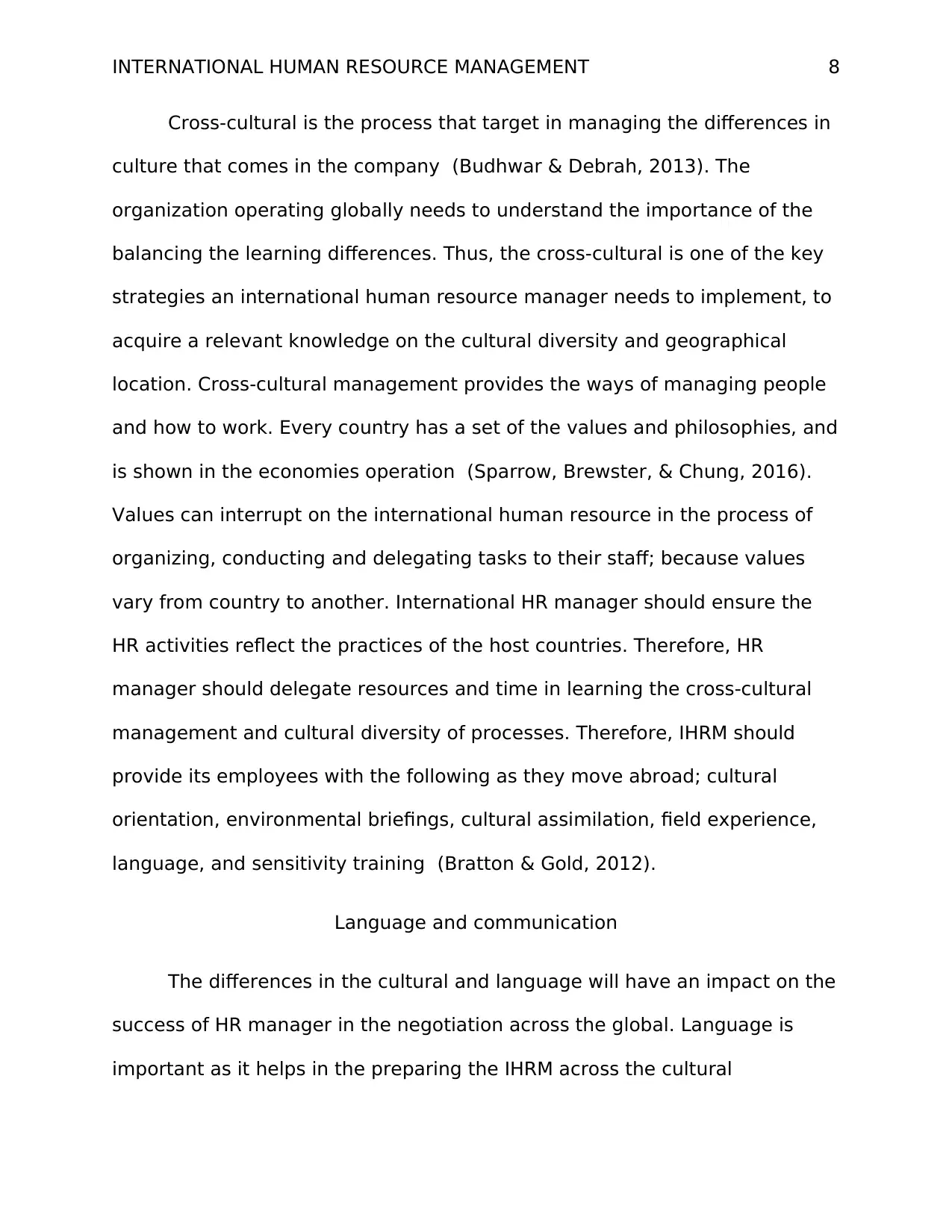
INTERNATIONAL HUMAN RESOURCE MANAGEMENT 8
Cross-cultural is the process that target in managing the differences in
culture that comes in the company (Budhwar & Debrah, 2013). The
organization operating globally needs to understand the importance of the
balancing the learning differences. Thus, the cross-cultural is one of the key
strategies an international human resource manager needs to implement, to
acquire a relevant knowledge on the cultural diversity and geographical
location. Cross-cultural management provides the ways of managing people
and how to work. Every country has a set of the values and philosophies, and
is shown in the economies operation (Sparrow, Brewster, & Chung, 2016).
Values can interrupt on the international human resource in the process of
organizing, conducting and delegating tasks to their staff; because values
vary from country to another. International HR manager should ensure the
HR activities reflect the practices of the host countries. Therefore, HR
manager should delegate resources and time in learning the cross-cultural
management and cultural diversity of processes. Therefore, IHRM should
provide its employees with the following as they move abroad; cultural
orientation, environmental briefings, cultural assimilation, field experience,
language, and sensitivity training (Bratton & Gold, 2012).
Language and communication
The differences in the cultural and language will have an impact on the
success of HR manager in the negotiation across the global. Language is
important as it helps in the preparing the IHRM across the cultural
Cross-cultural is the process that target in managing the differences in
culture that comes in the company (Budhwar & Debrah, 2013). The
organization operating globally needs to understand the importance of the
balancing the learning differences. Thus, the cross-cultural is one of the key
strategies an international human resource manager needs to implement, to
acquire a relevant knowledge on the cultural diversity and geographical
location. Cross-cultural management provides the ways of managing people
and how to work. Every country has a set of the values and philosophies, and
is shown in the economies operation (Sparrow, Brewster, & Chung, 2016).
Values can interrupt on the international human resource in the process of
organizing, conducting and delegating tasks to their staff; because values
vary from country to another. International HR manager should ensure the
HR activities reflect the practices of the host countries. Therefore, HR
manager should delegate resources and time in learning the cross-cultural
management and cultural diversity of processes. Therefore, IHRM should
provide its employees with the following as they move abroad; cultural
orientation, environmental briefings, cultural assimilation, field experience,
language, and sensitivity training (Bratton & Gold, 2012).
Language and communication
The differences in the cultural and language will have an impact on the
success of HR manager in the negotiation across the global. Language is
important as it helps in the preparing the IHRM across the cultural
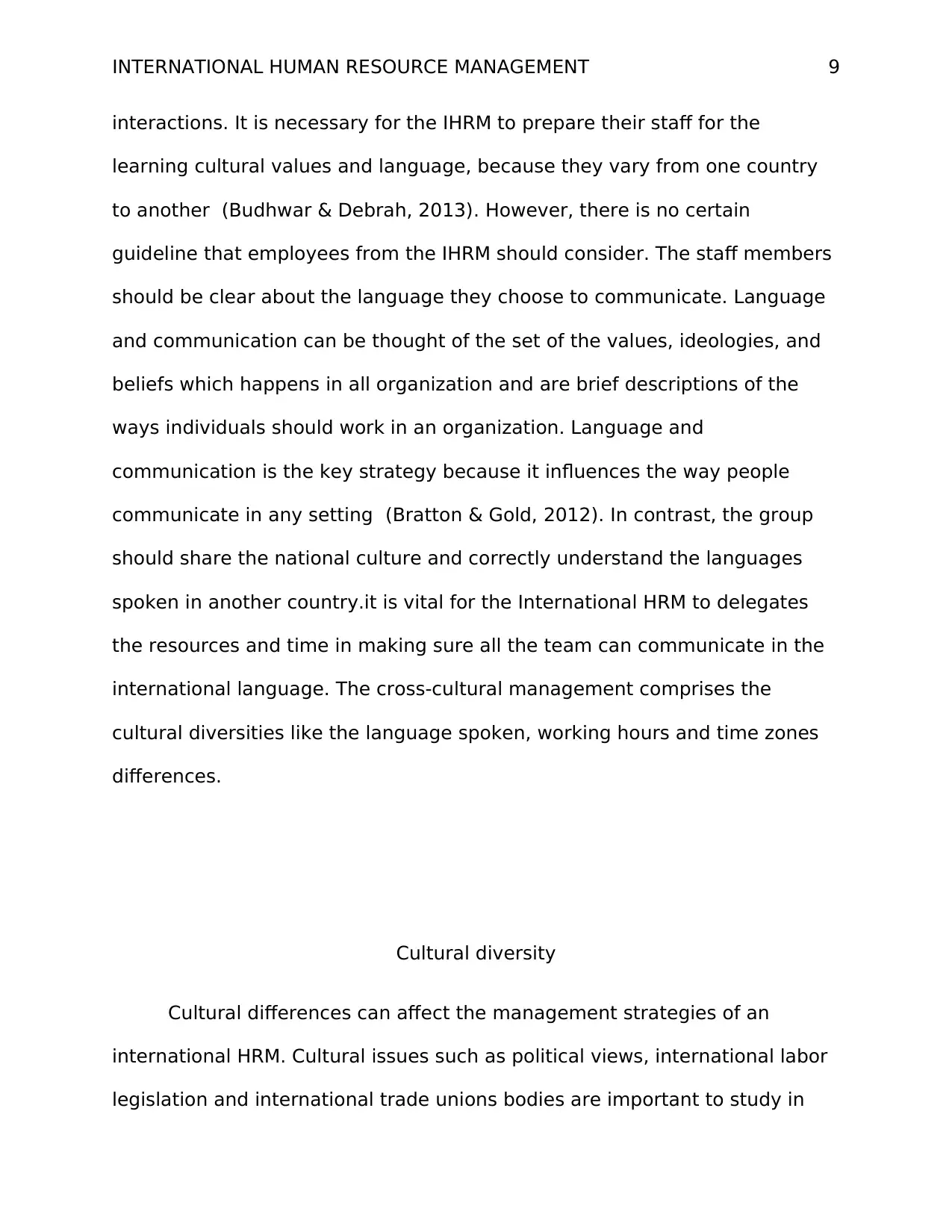
INTERNATIONAL HUMAN RESOURCE MANAGEMENT 9
interactions. It is necessary for the IHRM to prepare their staff for the
learning cultural values and language, because they vary from one country
to another (Budhwar & Debrah, 2013). However, there is no certain
guideline that employees from the IHRM should consider. The staff members
should be clear about the language they choose to communicate. Language
and communication can be thought of the set of the values, ideologies, and
beliefs which happens in all organization and are brief descriptions of the
ways individuals should work in an organization. Language and
communication is the key strategy because it influences the way people
communicate in any setting (Bratton & Gold, 2012). In contrast, the group
should share the national culture and correctly understand the languages
spoken in another country.it is vital for the International HRM to delegates
the resources and time in making sure all the team can communicate in the
international language. The cross-cultural management comprises the
cultural diversities like the language spoken, working hours and time zones
differences.
Cultural diversity
Cultural differences can affect the management strategies of an
international HRM. Cultural issues such as political views, international labor
legislation and international trade unions bodies are important to study in
interactions. It is necessary for the IHRM to prepare their staff for the
learning cultural values and language, because they vary from one country
to another (Budhwar & Debrah, 2013). However, there is no certain
guideline that employees from the IHRM should consider. The staff members
should be clear about the language they choose to communicate. Language
and communication can be thought of the set of the values, ideologies, and
beliefs which happens in all organization and are brief descriptions of the
ways individuals should work in an organization. Language and
communication is the key strategy because it influences the way people
communicate in any setting (Bratton & Gold, 2012). In contrast, the group
should share the national culture and correctly understand the languages
spoken in another country.it is vital for the International HRM to delegates
the resources and time in making sure all the team can communicate in the
international language. The cross-cultural management comprises the
cultural diversities like the language spoken, working hours and time zones
differences.
Cultural diversity
Cultural differences can affect the management strategies of an
international HRM. Cultural issues such as political views, international labor
legislation and international trade unions bodies are important to study in
⊘ This is a preview!⊘
Do you want full access?
Subscribe today to unlock all pages.

Trusted by 1+ million students worldwide
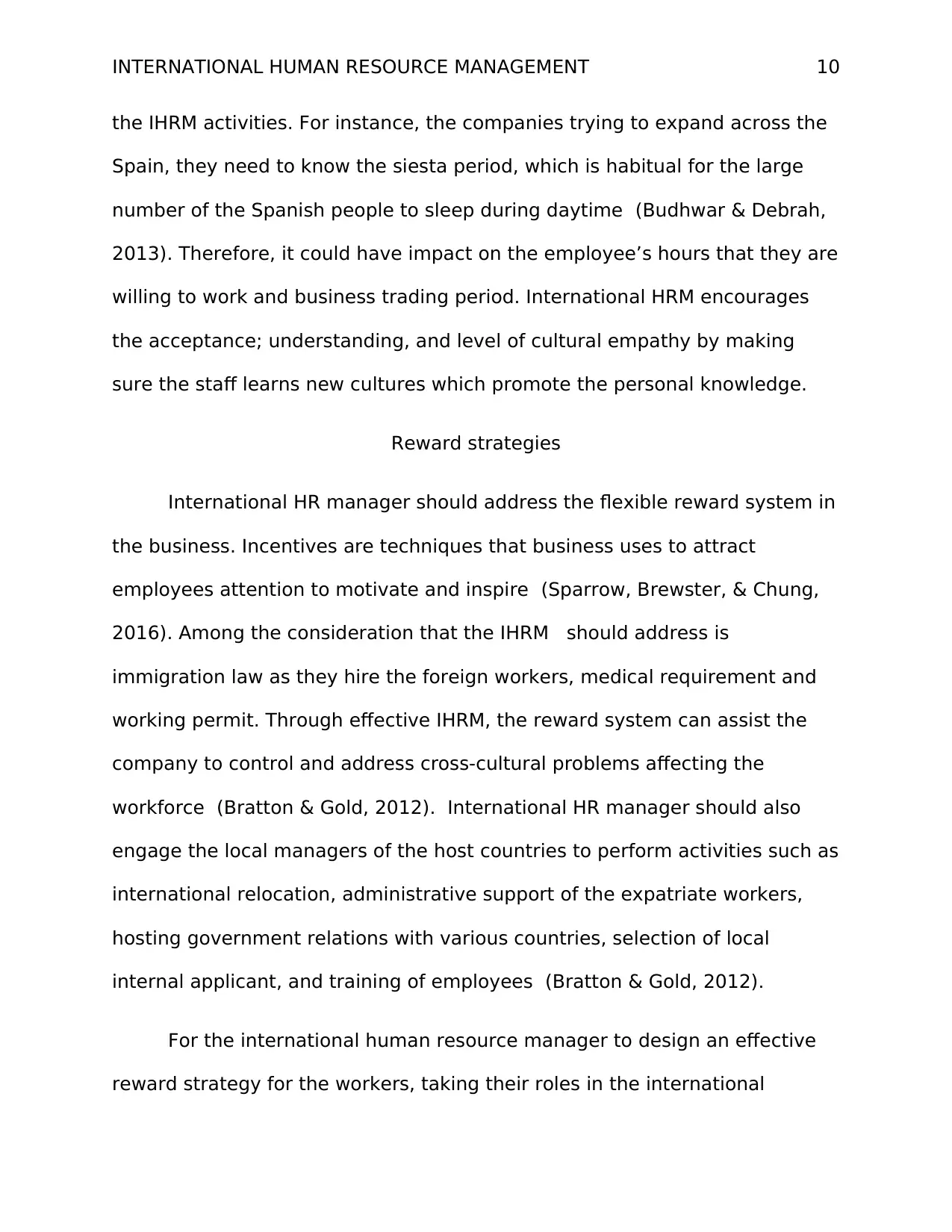
INTERNATIONAL HUMAN RESOURCE MANAGEMENT 10
the IHRM activities. For instance, the companies trying to expand across the
Spain, they need to know the siesta period, which is habitual for the large
number of the Spanish people to sleep during daytime (Budhwar & Debrah,
2013). Therefore, it could have impact on the employee’s hours that they are
willing to work and business trading period. International HRM encourages
the acceptance; understanding, and level of cultural empathy by making
sure the staff learns new cultures which promote the personal knowledge.
Reward strategies
International HR manager should address the flexible reward system in
the business. Incentives are techniques that business uses to attract
employees attention to motivate and inspire (Sparrow, Brewster, & Chung,
2016). Among the consideration that the IHRM should address is
immigration law as they hire the foreign workers, medical requirement and
working permit. Through effective IHRM, the reward system can assist the
company to control and address cross-cultural problems affecting the
workforce (Bratton & Gold, 2012). International HR manager should also
engage the local managers of the host countries to perform activities such as
international relocation, administrative support of the expatriate workers,
hosting government relations with various countries, selection of local
internal applicant, and training of employees (Bratton & Gold, 2012).
For the international human resource manager to design an effective
reward strategy for the workers, taking their roles in the international
the IHRM activities. For instance, the companies trying to expand across the
Spain, they need to know the siesta period, which is habitual for the large
number of the Spanish people to sleep during daytime (Budhwar & Debrah,
2013). Therefore, it could have impact on the employee’s hours that they are
willing to work and business trading period. International HRM encourages
the acceptance; understanding, and level of cultural empathy by making
sure the staff learns new cultures which promote the personal knowledge.
Reward strategies
International HR manager should address the flexible reward system in
the business. Incentives are techniques that business uses to attract
employees attention to motivate and inspire (Sparrow, Brewster, & Chung,
2016). Among the consideration that the IHRM should address is
immigration law as they hire the foreign workers, medical requirement and
working permit. Through effective IHRM, the reward system can assist the
company to control and address cross-cultural problems affecting the
workforce (Bratton & Gold, 2012). International HR manager should also
engage the local managers of the host countries to perform activities such as
international relocation, administrative support of the expatriate workers,
hosting government relations with various countries, selection of local
internal applicant, and training of employees (Bratton & Gold, 2012).
For the international human resource manager to design an effective
reward strategy for the workers, taking their roles in the international
Paraphrase This Document
Need a fresh take? Get an instant paraphrase of this document with our AI Paraphraser

INTERNATIONAL HUMAN RESOURCE MANAGEMENT 11
requires factors such as; firstly, clearly understanding the allowances for a
particular country (Sparrow, Brewster, & Chung, 2016). Secondly,
knowledge of the customs, environment, employment practices and laws of
the foreign countries are necessary. Finally, the familiarity with inflation
effect on compensation and the currency relationship are vital. For instance,
there is a need to understand the employment-related legislation in the
country for the managers to structure the active international reward
structure. For example, India has 45 labor laws at a national level and four at
the state government level (Budhwar & Debrah, 2013). The manager can
use a balance sheet approach to draw up an employee compensation
package. For the managers to achieve balance in the reward system, the
firms should take into account the following; income tax incurred, housing
allowances, cost of living allowances, medical, emergency and security
cover, relocation benefits, education allowances for expatriate children, and
contribution to the pension schemes and savings (Bratton & Gold, 2012).
Appraisal of the employee in a foreign country is crucial since it identifies
employee’s strengths and weakness; appraisal provides feedback for the
firm to improve the human resource planning. Finally, the evaluation shows
the obstacles blocking the organization progress and improves
communication.
Appropriate selection, recruiting and training method in the
international HRM is important factors that counter issues relating to the
globalization of the business activities that affect HRM.IHRM involves the
requires factors such as; firstly, clearly understanding the allowances for a
particular country (Sparrow, Brewster, & Chung, 2016). Secondly,
knowledge of the customs, environment, employment practices and laws of
the foreign countries are necessary. Finally, the familiarity with inflation
effect on compensation and the currency relationship are vital. For instance,
there is a need to understand the employment-related legislation in the
country for the managers to structure the active international reward
structure. For example, India has 45 labor laws at a national level and four at
the state government level (Budhwar & Debrah, 2013). The manager can
use a balance sheet approach to draw up an employee compensation
package. For the managers to achieve balance in the reward system, the
firms should take into account the following; income tax incurred, housing
allowances, cost of living allowances, medical, emergency and security
cover, relocation benefits, education allowances for expatriate children, and
contribution to the pension schemes and savings (Bratton & Gold, 2012).
Appraisal of the employee in a foreign country is crucial since it identifies
employee’s strengths and weakness; appraisal provides feedback for the
firm to improve the human resource planning. Finally, the evaluation shows
the obstacles blocking the organization progress and improves
communication.
Appropriate selection, recruiting and training method in the
international HRM is important factors that counter issues relating to the
globalization of the business activities that affect HRM.IHRM involves the

INTERNATIONAL HUMAN RESOURCE MANAGEMENT 12
management of the recruitment process from the home country of the firm
and the countries where the company obtain its workforce (Bratton & Gold,
2012). The enterprise should adopt a uniform recruitment system to find a
skilled employee with right cultural norms and behaviors (Bratton & Gold,
2012). Therefore, it will help to have uniformity of goals and objectives with
the human resources from one country to another. Both the domestic and
IHRM have the recruitment responsibilities, IHRM should have a higher
degree of the cultural sensitivity with efficient communication.
Training and development
Complex in training and development increases as the companies
moves internationally. The types of development and training depend on the
following factors; cultural expectations of the training, the extent of
centralization of management, types of the staff working in the subsidiaries,
extent and concentration of the brand so that the suppliers, distributors and
employees are aware of the brand image (Sparrow, Brewster, & Chung,
2016). Therefore, if it is a polycentric approach, the training will be more
local to correspond to the local culture.
Conclusion
The roles of the IHRM are challenging, complex and quite broader than
the domestic human resource management. IHRM involves the
internationalizing the standards of the selection, training, recruitment,
legality of the employment system, compensation and reward system.
management of the recruitment process from the home country of the firm
and the countries where the company obtain its workforce (Bratton & Gold,
2012). The enterprise should adopt a uniform recruitment system to find a
skilled employee with right cultural norms and behaviors (Bratton & Gold,
2012). Therefore, it will help to have uniformity of goals and objectives with
the human resources from one country to another. Both the domestic and
IHRM have the recruitment responsibilities, IHRM should have a higher
degree of the cultural sensitivity with efficient communication.
Training and development
Complex in training and development increases as the companies
moves internationally. The types of development and training depend on the
following factors; cultural expectations of the training, the extent of
centralization of management, types of the staff working in the subsidiaries,
extent and concentration of the brand so that the suppliers, distributors and
employees are aware of the brand image (Sparrow, Brewster, & Chung,
2016). Therefore, if it is a polycentric approach, the training will be more
local to correspond to the local culture.
Conclusion
The roles of the IHRM are challenging, complex and quite broader than
the domestic human resource management. IHRM involves the
internationalizing the standards of the selection, training, recruitment,
legality of the employment system, compensation and reward system.
⊘ This is a preview!⊘
Do you want full access?
Subscribe today to unlock all pages.

Trusted by 1+ million students worldwide
1 out of 15
Related Documents
Your All-in-One AI-Powered Toolkit for Academic Success.
+13062052269
info@desklib.com
Available 24*7 on WhatsApp / Email
![[object Object]](/_next/static/media/star-bottom.7253800d.svg)
Unlock your academic potential
Copyright © 2020–2025 A2Z Services. All Rights Reserved. Developed and managed by ZUCOL.




